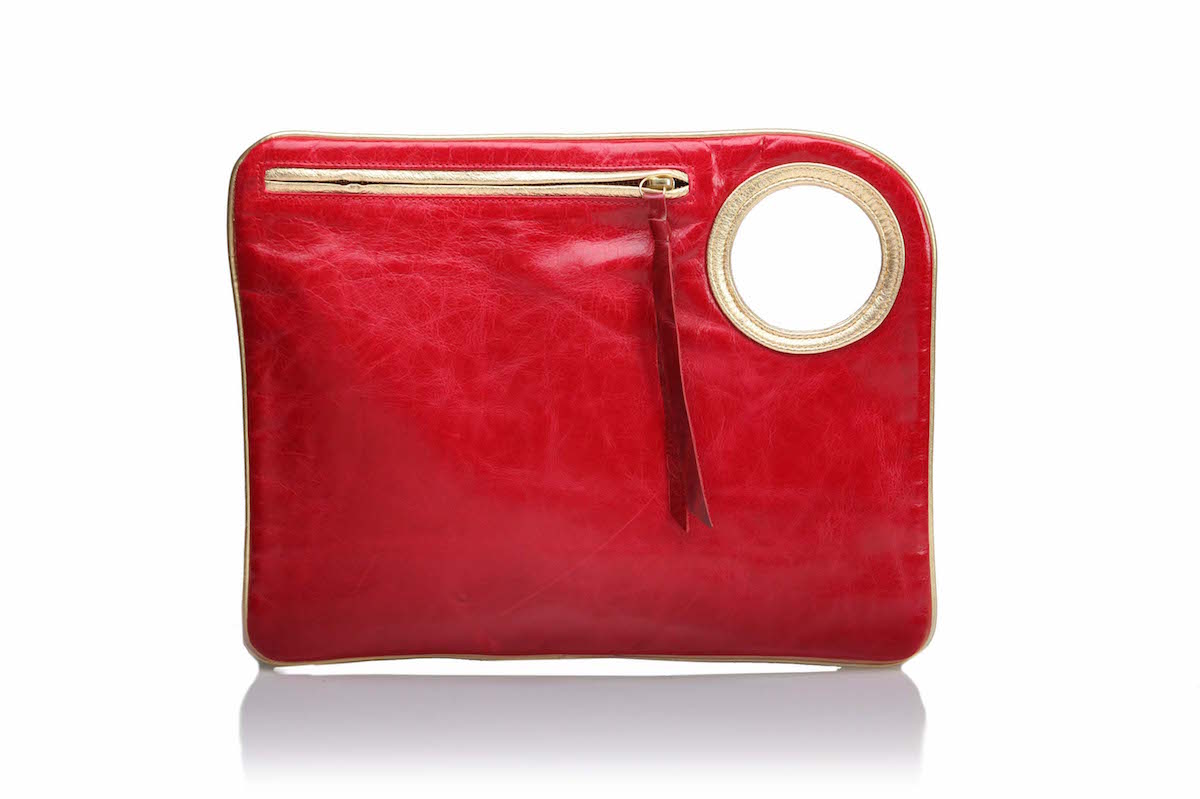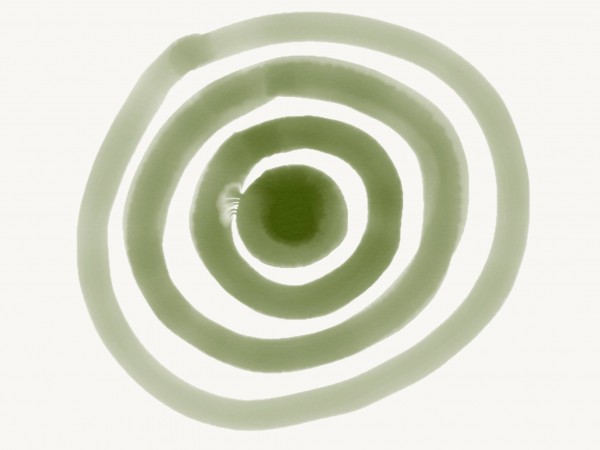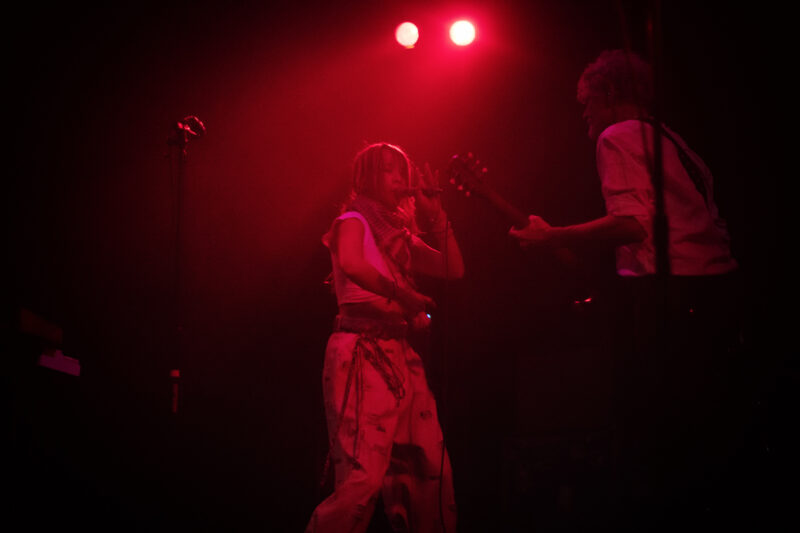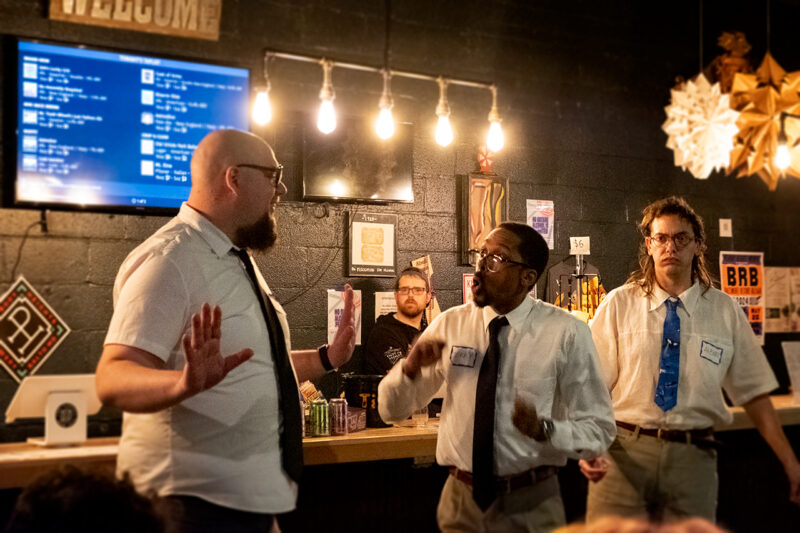An Interview with Victor F. de M. Torres of LIGHTHOLE by Joseph Shaikewitz
Daylight casts a very different impression of LIGHTHOLE—a recently established gallery of new media and intermedia art located in the Copycat Building. Its happenings typically occur late at night when the ebullient crowds, red and purple tinted lights, and audio of ongoing screenings purposefully overshadow the domestic setting. But as I enter the space one balmy afternoon, the sunlit interior reveals the mechanics of this four-month-old operation: bungee cords holding open a theatrical curtain; projectors and media players strategically mounted to sustain this incipient platform.
My enlightenment carries over as I speak with LIGHTHOLE’s founder and director, Victor F. de M. Torres. His excitement about this venture is palpable, though he speaks deliberately and with intention. Language is of the essence. A nearby radiator emits a soft hum and a steady trickle of vapor as if to reinforce the welcoming atmosphere that this gallery—as a showcase of interdisciplinary practices and meeting grounds for engaged audiences—has come to offer. It’s illuminating (to say the very least) to hear such integrity and forethought behind the artist-run space and to parse out the exploratory nature of its overlying approach in conversation.
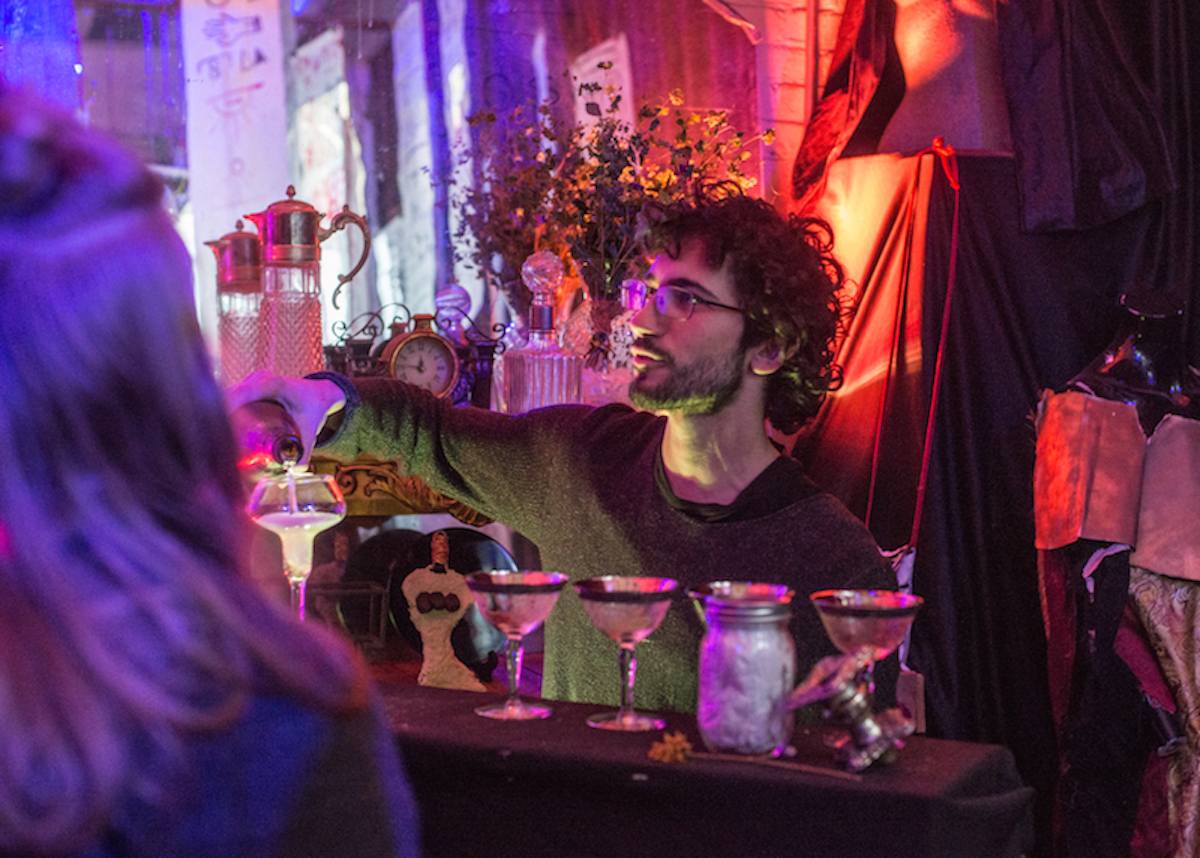
Victor F. de M. Torres: I went to an MFA program for intermedia and digital arts, which—through being exposed to people like Mark Tribe, Dick Higgins, and Lisa Moren—really compelled me to explore the realm of intermedia artists. Who are these people who call themselves ‘intermedia artists?’ Why has this word all of a sudden fallen out of favor? And I realized that this is intrinsically tied to new media in a more updated sense—because that word is really from the mid-60s and it relates to concrete poetry and Dadaism and ties in millennial art historical events. And so I’m fascinated by the idea of new media and intermedia as being kind of one in the same, or two-in-one.
Since that’s my background, I’ve been exploring work that is intrinsically interactive by sending a current through the participant’s body, so to speak. It’s a circuit, and so you connect one sculpture with another sculpture and then boom, there’s audio and video. And I am constantly looking for other people who do that, but not just in a technological way.
Let’s take for example our last show: Sonya Norko showed this piece that has to do with concrete poetry, linguistics, symbolism, and especially modes of representation through writing, Plus there’s a mannequin with trash bags, so there are so many media conglomerated into it. So it’s really about the idea. The idea comes first and then the media follows. But the idea comes first. However that idea needs to be concretized, it’s independent of a genre or medium. I’m constantly looking for creators or artists —however they call themselves—that do not limit themselves by a medium.
Joseph Shaikewitz: There was a really great artist talk from Miriam Simun in conjunction with her GhostFood project with The Contemporary where she defines her medium as making work “by whatever means necessary.” Is such a mindset in a similar vein to what you’re thinking through with intermedia art?
Absolutely. It’s conceptual by nature. You start out with the idea, the desire, and the obsession to make it come true and that idea is the thing that’s telling you how it should be materialized. Is it through your body, through your mouth, a computer? Really it requires one to do research and to experiment. And so it’s always experimental in a way. The word ‘experimental’ is kind of irrelevant because it’s almost taken for granted. And I think Baltimore is really about that.
So how has working within that understanding of intermedia art manifested itself in LIGHTHOLE, be it from a curatorial, methodological, or conceptual point of view?
That for me poses the necessity for space. So why do you need a space for something that doesn’t require a specific media and what does that space look like? In a way it’s research. I need to figure that out and I want to because I have an idea of what it looks like, but at the same time I’ve never seen it before. I’ve certainly seen versions of it. There’s a Brazilian movement called Neo-Concretism with artists like Helio Oiticica; it was all about vivência, which means the livability of the idea and the livability of thought. So how do you put the participant in a place where they are it, where they are the work, where they’re experiencing in a full sense of the word? It’s kind of Allan Kaprow-esque: how do you make audience not an audience? They’re not just sitting passively and consuming something.
I’m trying to allude to the question of: how can that person experience the art in a way that transcends however it is created physically? So I’ll give a more concrete example: something that really inspired me to do LIGHTHOLE is a queer film festival in New York called MIX NYC directed by Stephen Kent Jusick and it’s brilliant. People feel very safe, people of any sexual orientation or lifestyle come in and they make it their home. They might even sleep at the place. There’s food, drinks, bathrooms, a kitchen, and all these installations everywhere. At the same time, there’s a screening room. So really, how do you get people of non-normative identities to be represented in a visual or experiential way?
I think we’ve seen a fair amount of new media art sequestered to digital platforms, online museums, and virtual galleries, but that online space is still very much enmeshed in various power structures. For me, what’s so interesting about LIGHTHOLE is that you’re bringing new and intermedia art into a space that feels very experiential in the full sense of the word, as you say. So you come and you have a communal space with people sitting on the floor and on couches and it creates this strong sense of congregation as opposed to the alienating situation that we’re forced to operate within online.
Right, because the connection between online and us is the screen. And a mouse and a computer and a keyboard. And that’s the only way we can experience the ‘online.’ Except for the fact that we are it– we made it, it is human, we are it. So why not live it? Why does it have to be mediated by another contraption? Sure there are many reasons why it has to mediated; that’s why it’s accessible and that’s what makes it incredible.
There’s this quote by Mark Tribe where he says, “Much as Dada was in part a reaction to the industrialization of warfare and the mechanical reproduction of texts and images, New Media art can be seen as a response to the information technology revolution and the digitization of cultural forms.” So how do we deal with that? I think the next step is to really get out of the online. How do you bring the body back into this?
How have you been able to translate that idea of technology granting access into a physical space such as LIGHTHOLE?
First the warmness. If I have an announcement to make, it’s never using a microphone. It’s never a performance per se, it’s just me … being nervous and talking (laughs). It’s about talking to anybody who’s around you not as a persona but as yourself. People are in this home—this is a home, people live here. I’d love to get LIGHTHOLE out of my home, but at the same time it’s very important that it is here. And it’s important that wherever it will be next, that it be seen as a home because that’s where your computer is. It’s on your bed, your desk, in an intimate space. That’s where you feel like you can access the Internet in a very closed-door environment. That’s where you can rant and be angry and get out of control. It’s so personal. But you can forget this given that the Internet is so impersonal.
 Zach Trebino, WATCH!, 2015, durational, intermedia performance
Zach Trebino, WATCH!, 2015, durational, intermedia performance
So in a way you’re trying to create or duplicate this intimacy in real life?
Yes, or maybe it’s a new type of intimacy. But maybe it’s not. Maybe it’s very old, actually. I don’t know what it looks like entirely, I can only allude to places that I think approximate this. I would love to see people of any kind of orientation cuddling or displaying affection for each other in this space.
Something that I think about a lot in relationship to new media art—and it’s almost an antithesis to this notion of access—is the question of privilege. There’s this prevailing myth of the Internet as a fully accessible place when, conversely, there are still so many who don’t have access to that. Did you have to grapple with this idea in conceiving of this space?
I love that you’re asking me that. I come from a privileged background. I am an immigrant and that puts me in a limited, liminal standing in this society. So personally I have grappled with questions of accessibility, but not in the sense of access to the Internet, for example. Growing up during the very end of a dictatorship, American computers were contraband.
At first things had to be Brazilian, so most things that were American were contraband. We had Brazilian computers, but to get computers that could actually access the Internet in an effective way was completely illegal. And so we live in a city where a lot of people probably don’t have full access to the Internet and any art venture or project in this town needs to be very aware of this “great divide,” as Cara Ober has said. And this building—The Copycat—does not help it. Although there are people who are working very hard to create what I call “integrative actions”—because there was desegregation, but was there ever integration?
Any artistic venture in this city needs to be fully engaged with these social, economic, and racial factors because across all media, it comes down to questions of what are you watching? What are you consuming? How passively are you consuming? And then once it’s consumed, what are you emulating? You’re emulating what you’re consuming. You’re emulating the images, the symbols; you’re being spelled. You’re being taught what a heathen is and not to be that; what an idol is, who is to be idolized; who is the protagonist.
That’s what LIGHTHOLE is here for. I commit this project to really enter or engage how we can re-signify some of these modes of representation. How can we re-signify these very traditional notions of who’s getting what and who’s being represented by whom and how they’re being represented? And media is the only way. So it has to be something that encompasses any media because any media is representation. Like Marshall McLuhan says, “the medium is the message.” Any media is the message; it is the thing by itself, even if it’s not trying to say anything.
I like that this is at the fore of your thinking because I find that the question of audience in Baltimore is a tricky one. I mean, who are these cultural institutions claiming to serve vs. who are they actually serving? And with new media straddling this line of access and privilege, it becomes even more complex.
Building on that idea of medium, where does LIGHTHOLE’s journal series enter into the equation? Why have a publication in addition to a real time event and what might printed matter add to this very experiential project?
I love books. I feel like one day the Internet’s not going to exist. It’s a really frail thing. People might scoff at that, but I do have a hunch that this might happen. Personally, my work is writing. Even if it doesn’t seem that way, it’s binding and writing and printing and hieroglyphs and I make literature for a culture that doesn’t exist. To me, going to a country where I couldn’t access the words in a book—I couldn’t read history books and I couldn’t do my homework—provides the personal side of it.
I conquered something by learning the language and now I can contribute to this society. I went through something that I thought would be impossible and now I can talk to you like this and do research in English and make books. That to me was a really big deal. I was really grateful that I could do it, almost like a performance.
I think that in tying a book to an event, which in nature is so ephemeral, there has to be something that lingers. I just want to see all these artists published. What is a way to elevate art in a really effective way? These people should be acknowledged right now for what they’re doing.
It’s a way of writing granting legitimacy.
Exactly. It’s weird how this culture works, but in Western civilization we grow up to think that if it’s printed somewhere, it equates to the symbol of legitimacy. But nowadays, because of the Internet, we can all publish things in a very legitimate way.
Given your preexisting relationship with writing, do you find that this impacts the voice that you assume or the content that you publish?
I don’t think it’s explicit. There’s nothing in the journals that makes you think, “this is written by an immigrant”—except for the typos (laughs). But it’s not just my writing. Actually most of it is the artists that I’m curating and I try to make most of it their voice coming through. I ask them to keep in mind how they can tie their pieces to the theme and I remove myself from the part of critic. I do evaluate the writing to see if it actually fits, but it’s great to see that people can take their work to a critical or literary place. It’s an intermedia act: you’re translating your piece to another medium for posterity. How is this event going to be remembered, archived?
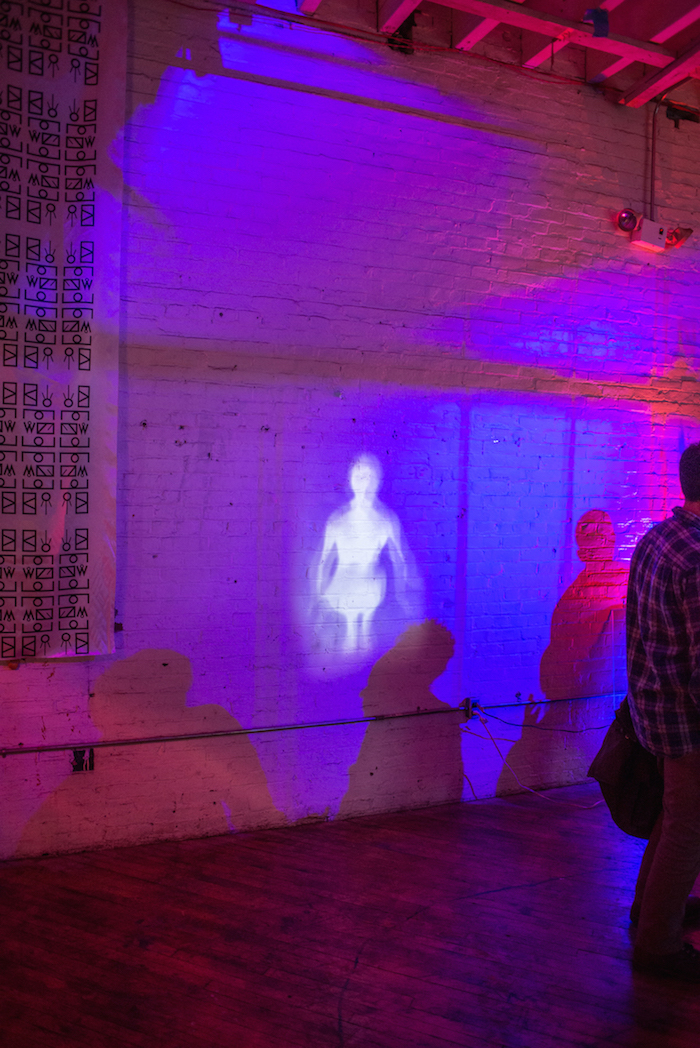 Kata Frederick, Floating, 2015, video installation
Kata Frederick, Floating, 2015, video installation
Is that archival impulse something that’s important to you in running this space in knowing that, despite how we might like to hope otherwise, it may not be around forever and that it does have a finite quality? Through the archival, are you seeing yourself thinking about the legacy or the afterlife?
I’m not sure if I’m thinking about its death. I’m thinking more about its longevity. I’ve never deleted a picture. Actually that’s a lie (laughs), but I keep pictures from anything. I’m just that kind of person. I’ve grown up with little microcassette tape recorders. I would ask my grandfather to sing songs for me and record them and I still have them. I like libraries. I like to archive. I have a compulsion for it; it’s an obsession.
My goal is to make this project outlive me—I would love that and I’m actually going to die trying. Who else is going to do it? Nobody else.
Where would you like to see this project be years and decades into the future? What are your aspirations for this space and what are you looking to improve on?
There’s so much to improve on. There’s so much. I want this project to be able to sustain itself completely without any sort of dependency on any other institution or organization. I know that’s a lot, but I really think that will happen. And like I said, I’m going to die trying. I burned my ships on the beach. I burned my bridges.
I want to have more contributors; I want more people to submit stuff. I guess I have phases in my head: first, I want to have more of a community-bound project that’s local and then after it transcends that I think about it nationally and gaining more acclaim. I’m ambitious about it. It’s going to cost a lot and it’s going to involve a lot of perseverance and a lot of failures. Hopefully more successes than failures.
With that development and acclaim, I wonder how you stay true to the roots of this space. How do you foster growth without losing the pure spirit of LIGHTHOLE as it exists now?
I’m going to refute this with one of my favorite quotes by Helio Oiticica: “Purity is a myth.” It’s a quote that really united Brazil at the time and if there’s anything that Brazilian culture has to offer the world, it’s that idea that we’ve all moved from so far and that we’ve all gone so many places. There’s no origin anymore. I mean we know—Africa—but purity, if you think about it, has to do with origins, lineage, and where this thread comes from. I’m not trying to use this argument to justify any sort of Machiavellic methods—there’s no ends justify the means—but things are going to change. They’re going to change a lot. If there’s anything true about this project, it’s that it’s going to change. It has to change and I’m working on that.
As flawed as the Internet may be, as we’ve discussed, it does provide an interesting analog or visualization of this idea that there is no purity. It’s something that is constantly being updated, adapted, and re-configured. It has this almost poetic promise that we can forge new paths and head in new directions.
Right, it’s organic. Anything that’s organic changes. It has a lifespan of some sort. It dies. With plants, some of them die and then they’re born again. The Internet is like its own being. The idea of a meme as something that has almost its own agency. I feel like the umbilical cord will be cut at some point and it has to be. And hopefully it will be able to walk and talk and get a job. Hopefully we can get more quality prints, but still make them accessible; maybe have nice ones with hard covers and many different kinds. Monographic ones. I would love to make many different types of publications. A whole library—a room full of books and journals and videos and everything. I think it’ll be great. If there’s anything I’m really excited about, it’s this thing.
Author Joseph Shaikewitz is a Baltimore-based writer and curator from St. Louis, MO. He is the Gallery Manager at Hamiltonian Gallery in DC and a graduate of Johns Hopkins University.
Top Image: LIGHTHOLE by Victor F. de M. Torres
